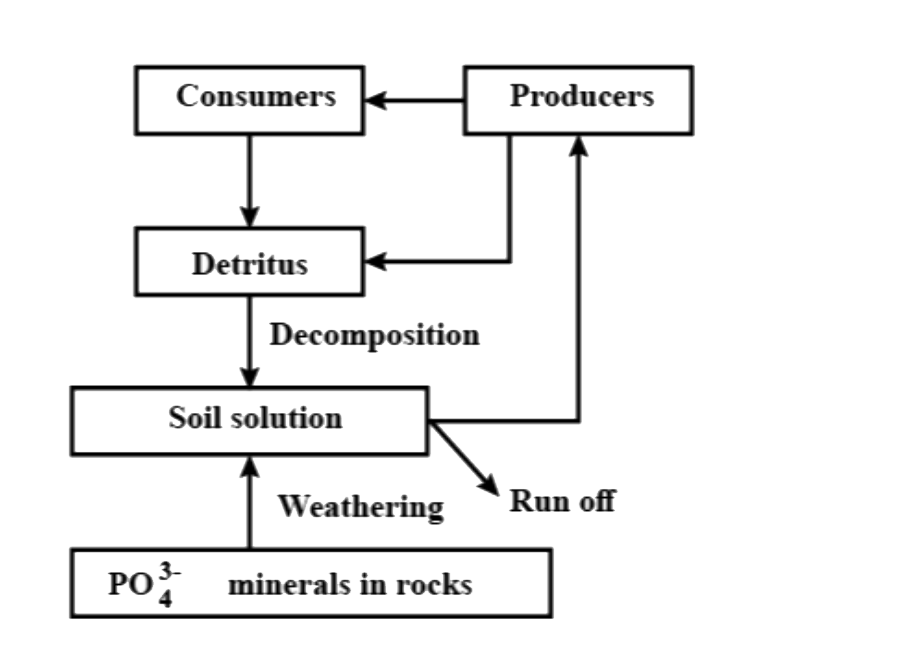What are biogeochemical cycles ?
Step-by-Step Solution:
1. Definition of Biogeochemical Cycles:
- Biogeochemical cycles refer to the cyclic movement of substances (elements and compounds) through both abiotic (non-living) and biotic (living) components of the ecosystem.
2. Components Involved:
- The cycles involve two main types of components:
- Abiotic Components: These include elements like water, carbon, nitrogen, phosphorus, and other minerals found in the environment.
- Biotic Components: These include living organisms such as plants, animals, and microorganisms.
3. Cyclic Movement:
- The process involves the transfer of these substances from abiotic components to biotic components and then back to abiotic components. This movement is continuous and helps maintain the balance of ecosystems.
4. Example of a Biogeochemical Cycle:
- A common example is the Carbon Cycle:
- Carbon exists in the atmosphere as carbon dioxide (CO2).
- Plants absorb CO2 during photosynthesis, converting it into organic matter.
- Animals consume plants, incorporating carbon into their bodies.
- When plants and animals die, decomposers break down their bodies, returning carbon to the soil.
- Eventually, carbon is released back into the atmosphere, completing the cycle.
5. Importance of Biogeochemical Cycles:
- These cycles are crucial for sustaining life on Earth. They ensure the availability of essential nutrients, regulate climate, and support various ecological processes.
- Biogeochemical cycles refer to the cyclic movement of substances (elements and compounds) through both abiotic (non-living) and biotic (living) components of the ecosystem.
- The cycles involve two main types of components:
- Abiotic Components: These include elements like water, carbon, nitrogen, phosphorus, and other minerals found in the environment.
- Biotic Components: These include living organisms such as plants, animals, and microorganisms.
- The process involves the transfer of these substances from abiotic components to biotic components and then back to abiotic components. This movement is continuous and helps maintain the balance of ecosystems.
- A common example is the Carbon Cycle:
- Carbon exists in the atmosphere as carbon dioxide (CO2).
- Plants absorb CO2 during photosynthesis, converting it into organic matter.
- Animals consume plants, incorporating carbon into their bodies.
- When plants and animals die, decomposers break down their bodies, returning carbon to the soil.
- Eventually, carbon is released back into the atmosphere, completing the cycle.
- These cycles are crucial for sustaining life on Earth. They ensure the availability of essential nutrients, regulate climate, and support various ecological processes.
Topper's Solved these Questions
- ECOSYSTEM Book:MODERN PUBLICATIONChapter:ECOSYSTEM Exercise:NCERT FILE SOLVED (NCERT Exercise Questions)
Explore 17 Videos
- ECOSYSTEM Book:MODERN PUBLICATIONChapter:ECOSYSTEM Exercise:NCERT Exemplar Problems (A. MULTIPLE CHOICE QUESTIONS)
Explore 20 Videos
- ECOSYSTEM Book:MODERN PUBLICATIONChapter:ECOSYSTEM Exercise:PRACTICE PROBLEMS - CHARACTERISTICS OF ECOSYSTEM
Explore 14 Videos
- BIOTECHNOLOGY AND ITS APPLICATIONSBook:MODERN PUBLICATIONChapter:BIOTECHNOLOGY AND ITS APPLICATIONSExercise:CHAPTER PRACTICE TEST (SECTION - E)
Explore 2 Videos
- EVOLUTIONBook:MODERN PUBLICATIONChapter:EVOLUTIONExercise:CHAPTER PRACTICE TEST (SECTION-D)(CASE-BASED SHORT ANWER )(THREE MARK EACH)
Explore 2 Videos
Similar Questions
What is a biogeochemical cycle. What is the role of the reservoir in a biogeochemical cycle? Give an example of a sedimentary cycle with reservoir located in earth's crust.
View SolutionWhat are the three biogeochemical cycles that play prominent roles in the biosphere?
(a)_________.
(b)_______.
(c ) _______.
View Solution
Knowledge Check
Select the pairs of sediamentary biogeochemical cycles.
I. Hydrogen cycle and water cycle
II. Phosphorus cycle and sulphur cycle
III. Calcium cycle and magnesium cycle
IV. Carbon cycle and nitrogen cycleAI and IIBII and IIICIII and IVDI and IVWhich is not a gaseous biogeochemical cycle?
ASulphurBPhosphorusCNitrogenDCarbonWhich of the following statements about biogeochemical cycles is false?
ACarbon and nitrogen cycle faster than phosphorusBAll biogeochemical cycles include both organisms and non-living componentsCMost elements ramain longest in the living portion of their cycleDYour may have atoms in your body that were once part of a dinosaur
Why are nutrient cycles in nature called biogeochemical cycles?
View SolutionThe diagram/flow chart represents which of the sedimentary biogeochemical cycle ?

View SolutionName two types of biogeochemical cycles ?
View SolutionWhich of the following statements about biogeochemical cycles is not true?
View SolutionWhich of the following statements about biogeochemical cycles is false?
View Solution

